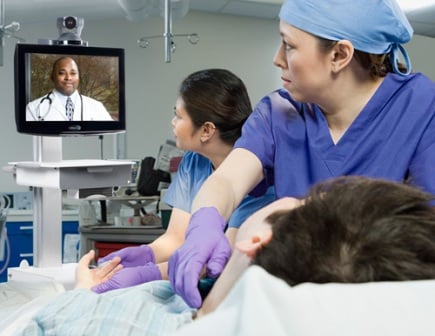Video conferencing has been used in a host of different environments to provide live video and audio streams via personal computers so an individual or group of people can communicate, share documents and discuss topics with others who are in multiple locations. It has been a quick and easy means to bring people at different sites together, to engage in meetings with clients and/or colleagues, or participate in educational training or instruction.
In such situations, videoconferencing can make all the difference to collaborate in real-time while saving time and money. In fact, for many businesses, it has reduced travel expenses and enabled on-screen face-to-face contact at the spur of the moment.
The use of videoconferencing technology has provided a communication solution with unlimited possibilities for businesses of all sizes, and it has become more prevalent in the delivery of health-related services and information.

Through a videoconference, medical practitioners can remotely discuss a case or even participate and assist in surgical operations while virtually present in operating rooms to provide timely support to the surgeon, who may be less experienced or familiar with the patient.
Indeed, videoconferencing and telepresence are able to improve, maintain or assist patients' health status. These techniques can even reduce unnecessary hospitalizations. Conference using Polycom video solutions, for instance, can treat stroke victims as well as accelerate the process of providing timely diagnosis and effective treatment for a wide range of serious and life-threatening conditions.
A patient that is suffering from an illness or disease can benefit from expert guidance; sometimes, that help comes from their own personal physician, while other times, the best assistance can come by a third-party doctor, physician or specialist who may be anywhere in the world.
There are many hospitals that have benefitted from using a video conferencing solution; among them is Our Lady of the Lake Regional Medical Center, which has called upon the technology to “connect with patients when they most need it…to remotely treat patients suffering from strokes.”
Just over a year ago, as reported by WAFB 9 News, a CBS-affiliated television station for Baton Rouge, La., “the Lake created the Telestroke Medicine Program.” This is a system to provide life-saving stroke care to patients that reside in less populated areas.
As WAFB mentioned, this program connects the Lake to West Feliciana Parish Hospital to the Lane Regional Hospital, St. Elizabeth Hospital and the Lake's Livingston branch. The TV station pointed out that, because healthcare specialists are “not always available at every location or every emergency room,” this is where the Telestroke program comes in to play, providing 24/7 stroke coverage where a neurologist will be contacted regarding the treatment of stroke patients.
Telestroke, a term associated to stroke telemedicine, is making use of state-of-the-art video telecommunications to provide stroke patients in remote areas quality stroke care via two-way video and audio communication. The technology in place allows community hospitals to have access to direct, immediate video consultation with stroke neurology experts.
Strokes are “the No. 4 cause of death and a leading cause of disability in the United States,” affirms the American Heart Association. For stroke victims, being treated through a computer that uses high-definition video conferencing can be the difference between life and death, as Baton Rouge neurologist Dr. Jay Acosta explained. The system serves as an aid to medical staff on scene taking care of stroke victims who need rapid treatment, when needed and in time. Furthermore, a doctor, such as himself, with this means can assess patients in real-time to further areas of treatment or give advice on recovery procedures.
Whether for medical consultation, to discuss a case, transmit medical images for diagnosis, or enable remote telemonitoring to overlook patients suffering from heart disease and stroke, an infrastructure supporting videoconferencing may just prove to be a lifesaver, especially in emergency cases.
Edited by
Alisen Downey